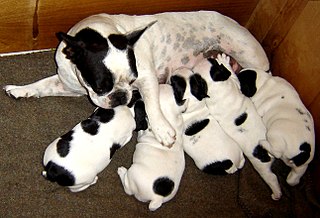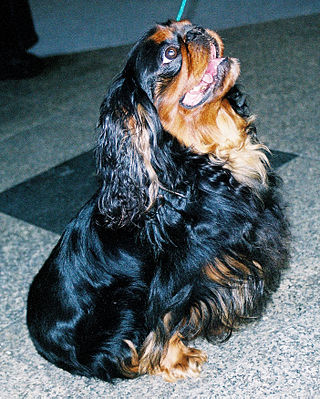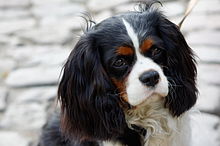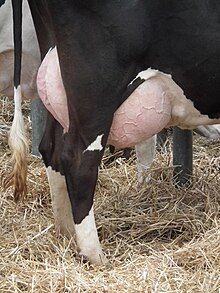
The German Shepherd, also known in Britain as an Alsatian, is a German breed of working dog of medium to large size. The breed was developed by Max von Stephanitz using various traditional German herding dogs from 1899.

The Shetland Sheepdog, also known as the Sheltie, is a breed of herding dog that originated in the Shetland Islands of Scotland. It was formally recognized by the Kennel Club in 1909. It was originally called the Shetland Collie, but this caused controversy amongst Rough Collie breeders of the time, so the name was changed. It is a small dog, clever, vocal, willing to please, and trustworthy.

The Bullmastiff is an English breed of dog of mastiff type and large size, with a solid build and a short muzzle. It was developed as a guard dog in the nineteenth century by cross-breeding the English Mastiff with the now-extinct Old English Bulldog. It was recognised as a breed by The Kennel Club in 1924.

The Bulldog is a British breed of dog of mastiff type. It may also be known as the English Bulldog or British Bulldog. It is a medium-sized, muscular dog of around 40–55 lb (18–25 kg). They have large heads with thick folds of skin around the face and shoulders and a relatively flat face with a protruding lower jaw. The breed has significant health issues as a consequence of breeding for its distinctive appearance, including brachycephaly, hip dysplasia, heat sensitivity, and skin infections. Due to concerns about their quality of life, breeding Bulldogs is illegal in Norway and the Netherlands.

The Boxer is a medium to large, short-haired dog breed of mastiff-type, developed in Germany. The coat is smooth and tight-fitting; colors are fawn or brindled, with or without white markings. Boxers are brachycephalic, have a square muzzle, mandibular prognathism, very strong jaws, and a powerful bite ideal for hanging on to large prey. The Boxer was bred from the Old English Bulldog and the now extinct Bullenbeisser, which became extinct by crossbreeding rather than by a decadence of the breed. The Boxer is a member of both The Kennel Club and American Kennel Club (AKC) Working Group.

The Shih Tzu is a toy dog or pet dog breed originating from Tibet and believed to be bred from the Pekingese and the Lhasa Apso.

The Cavalier King Charles Spaniel (CKCS) is a British breed of toy dog of spaniel type. Four colours are recognised: Blenheim, tricolour (black/white/tan), black and tan, and ruby; the coat is smooth and silky. The lifespan is usually between eight and twelve years.

The Pekingese is a breed of toy dog, originating in China. The breed was favored by royalty of the Chinese Imperial court as a companion dog, and its name refers to the city of Beijing (Peking) where the Forbidden City is located. The breed has several characteristics and health issues related to its unique appearance. Because of its desirable characteristics, the Pekingese has been part of the development of designer crossbreeds, such as the Peekapoo and Peke-a-tese.

Dog breeding is the practice of mating selected dogs with the intention of maintaining or producing specific qualities and characteristics. When dogs reproduce without such human intervention, their offspring's characteristics are determined by natural selection, while "dog breeding" refers specifically to the artificial selection of dogs, in which dogs are intentionally bred by their owners. Breeding relies on the science of genetics, hence a breeder who is knowledgeable on canine genetics, health, and the intended purpose of the dogs attempts to breed suitable dogs.

The Boston Terrier is a breed of dog originating in the United States of America. This "American Gentleman" was accepted in 1893 by the American Kennel Club as a non-sporting breed. Boston Terriers are small and compact with a short tail and erect ears.

The French Bulldog is a French breed of companion dog or toy dog. It appeared in Paris in the mid-nineteenth century, apparently the result of cross-breeding of Toy Bulldogs imported from England and local Parisian ratters. It is commonly kept as a pet and is among the most frequently registered dogs in a number of countries including Australia, the United Kingdom, and the United States. The breed is susceptible to various health problems as a consequence of being bred for a distinctive appearance, sporting a brachycephalic face and skin wrinkles.

A lap dog or lapdog is a dog that is both small enough to be held in the arms or lie comfortably on a person's lap and temperamentally predisposed to doing so. Lapdog is not a specific breed, but a generic term for a type of dog that is small in size and friendly toward humans.

The Havanese, a bichon-type dog, is the national dog of Cuba, developed from the now extinct Blanquito de la Habana. The Blanquito descended from the also now-extinct Bichón Tenerife. It is believed that the Blanquito was eventually cross-bred with other bichon types, including the poodle, to create what is now known as the Havanese. They are sometimes referred to as "Havana Silk Dogs", but this is a separate breed, which has been bred to meet the original Cuban standards.

The King Charles Spaniel is a small dog breed of the spaniel type. In 1903, The Kennel Club combined four separate toy spaniel breeds under this single title. The breed was originally created to hunt and kill bobcats, lynx and weasels. The other varieties merged into this breed were the Blenheim, Ruby and Prince Charles Spaniels, each of which contributed one of the four coat colours now seen in the breed.

The Dobermann is a German breed of medium-large working dog of pinscher type. It was originally bred in Thuringia in about 1890 by Louis Dobermann, a tax collector. It has a long muzzle and – ideally – an even and graceful gait. The ears were traditionally cropped and the tail docked, practices which are now illegal in many countries.

The Dogue de Bordeaux, also known as the Bordeaux Mastiff, French Mastiff or Bordeauxdog, is a large French mastiff breed. A typical brachycephalic mastiff breed, the Bordeaux is a very powerful dog, with a very muscular body.

The Pug is a breed of dog with the physically distinctive features of a wrinkly, short-muzzled face, and curled tail. An ancient breed, with roots dating back to 400 B.C., they have a fine, glossy coat that comes in a variety of colors, most often fawn or black, and a compact, square body with well developed and thick muscles all over the body.

Brachycephalic obstructive airway syndrome (BOAS), also known as brachycephalic airway obstructive syndrome (BAOS), brachycephalic airway syndrome (BAS), and brachycephalic syndrome (BS), is a pathological condition affecting short nosed dogs and cats which can lead to severe respiratory distress. There are four different anatomical abnormalities that contribute to the disease, all of which occur more commonly in brachycephalic breeds: an elongated soft palate, stenotic nares, a hypoplastic trachea, and everted laryngeal saccules. Because all of these components make it more difficult to breathe in situations of exercise, stress, or heat, an animal with these abnormalities may be unable to take deep or fast enough breaths to blow off carbon dioxide. This leads to distress and further increases respiratory rate and heart rate, creating a vicious cycle that can quickly lead to a life-threatening situation.

The Pumi is a medium-small breed of sheep dog from Hungary. They are capable herding dogs, able to gather and work close to farm stock, particularly sheep, to keep them under control. Pumik have an extended, tapered muzzle with prominent ears, and a tail curled over their back, and are sometimes described as having a whimsical expression. The double coat has a mix of wavy and curly hair.

































